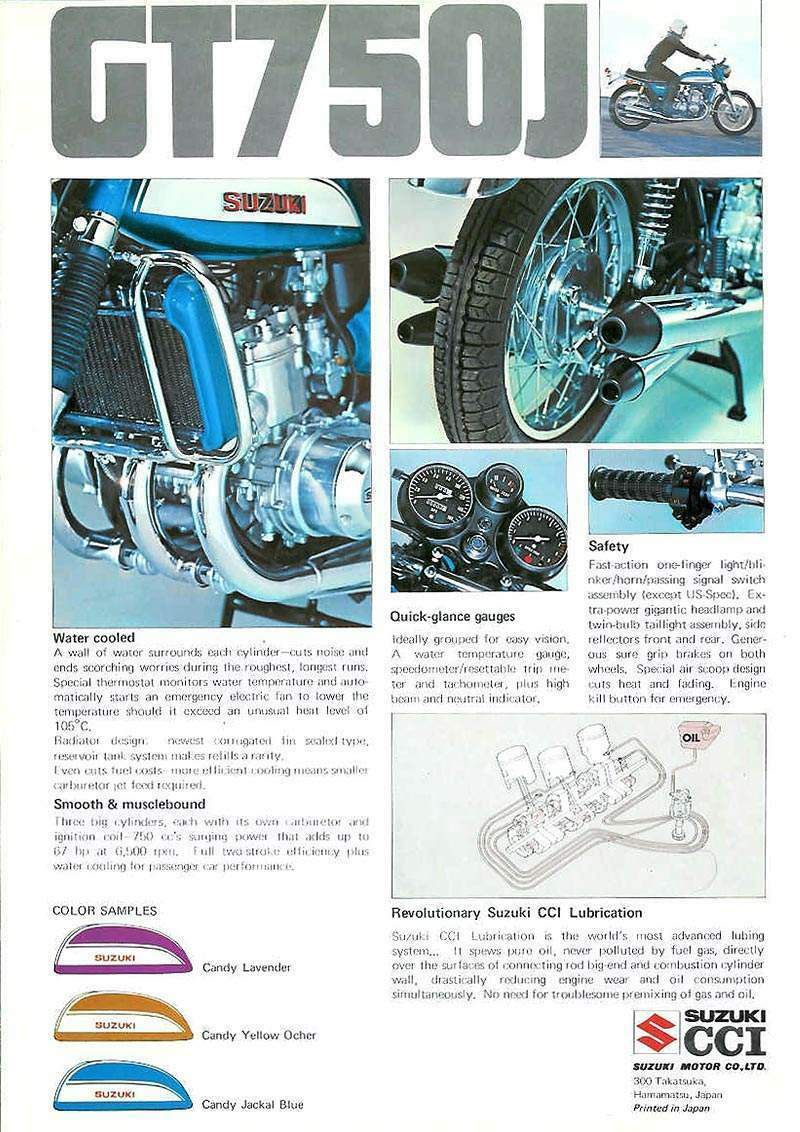
|
|
|
|
|
|
Classic Bikes
Custom Bikes
Individual
Racing Bikes AJP
AJS
Aprilia
Ariel
Avinton / Wakan
Bajaj
Benelli
Beta
Bimota
BMW
Brough Superior
BRP Cam-Am
BSA
Buell / EBR
Bultaco
Cagiva
Campagna
CCM
CF Moto
Combat Motors
Derbi
Deus
Ducati
Excelsior
GASGAS
Ghezzi Brian
Gilera
GIMA
Harley Davidson
Hero
Highland
Honda
Horex
Husaberg
Husqvarna
Hyosung
Indian
Jawa
Kawasaki
KTM
KYMCO
Laverda
Lazareth
Magni
Maico
Mash
Matchless
Mondial
Moto Guzzi
Moto Morini
MV Agusta
MZ / MuZ
NCR
Norton
NSU
Paton
Peugeot
Piaggio
Revival Cycles
Roland Sands
Royal Enfield
Sachs
Sherco
Sunbeam
Suzuki
SWM
SYM
Triumph
TVS
Ural
Velocette
Vespa
Victory
Vincent
VOR
Voxan
Vyrus
Walt Siegl
Walz
Wrenchmonkees
Wunderlich
XTR / Radical
Yamaha
Zero
Video
Technical
Complete Manufacturer List
|
Suzuki GT 750 “Le Mans”
It was during the early 1970s that the superbike war between the major Japanese factories broke out. Honda had already introduced the four-cylinder CB750 in 1969 and it did not take long before Suzuki weighed in with their new superbike contender. Suzuki, however, took a completely different route with their machine, the GT750. For a start their superbike was a two-stroke of 750 cc, the largest two-stroke ever to be put into mass production. Set across the frame the engine had three cylinders and was water-cooled. Although marketed as a direct rival to the Honda CB750 it soon became obvious that the Suzuki lacked the outright performance of the Honda and eventually the GT750 found its own little niche as a high-speed tourer. Nevertheless it was still a fascinating machine.
The internals of the unit were quite straightforward with piston porting, a roller-bearing crankshaft, oversquare configuration and triple 40 mm constant-vacuum carburettors. Water-cooling, apart from helping the engine to run at a more even temperature gave the all-alloy unit a very neat appearance indeed as it didn't demand conventional finning. With a 6.9:1 compression ratio the engine produced a respectable 70 bhp at 6500 rpm and a thumping 61-51 lb ft of torque at 5500 rpm. That figure may sound quite surprising as one usually associates a 'stroker' with a rather peaky engine, when in fact the bike produced more torque than many four-stroke machines of similar size. What is apparent on the road is that the GT750 was a very smooth bike indeed with no power band to catch an unwary rider offguard. An electric starter was fitted to the GT and got the engine into life with cons mate ease, to tick over quite sweetly at just over 1000 rpm. Throttle response was instantaneous it was quite easy to overstep the red line. Acceleration from a standing start was quite impressive was accompanied by quite a lot of blue smoke fn the four exhaust pipes. The quarter mile came up 13.3 seconds with a terminal speed of just a 100mph which, although not quite in the same league as the later four-stroke GS750, was still respectable for a three-quarter litre bike which was built primarily as a tourer.
Fuel consumption was excellent for such a bike with an average of just over 40mpg being possible and reaching an astonishing 55-60mpg if the bike was driven gently. With a fuel tank of 3.75 gal capacity a touring range of around 200 miles could be expected. Although the engine was very smokey especially when idling, oil consumption was really quite reasonable with over 300 miles available for each pint; the oil tank capacity was 3.2 pints, so a range of 900 miles or so was possible. The most disappointing feature of the Suzuki was its handling which was far from ideal. On smooth roads it was adequate until the speed increased! when the front and rear ends seemed to have precious little connecting them. On rougher surface the problem was accentuated and progress could be a very bumpy and hair-raising affair. If the rider held on and got used to the tough ride he found there was very little ground clearance with the side and centre stands dragging into the tarmac. Braking was by twin discs at the front and a drum at the rear which were adequate in the dry but pro to hesitation in wet weather. Luckily, with a drum, some retardation was possible while the fn discs were drying out. The GT750 weighed a hefty 540 lb dry but the bike was still quite easy to manoeuvre in and out of traffic and the engine made no fuss at all at low speeds even though there was still the characteristic two-stroke blue smoke gently puffing from! the pipes. In the end it was the exhaust emission! which killed the bike as it was just too dirty for tin ecology minded late 1970s and early 1980s. In its life the GT750 engine had been developed a for the road and completely for the tracks where in superbike racing with around 115 bhp at its disposal the works bikes won several championships mostly with Barry Sheene at the helm. Source of review : Super Bikes by Mike Winfield 
|
|
|
Any corrections or more information on these motorcycles will be kindly appreciated. |